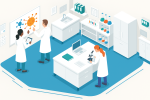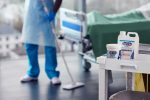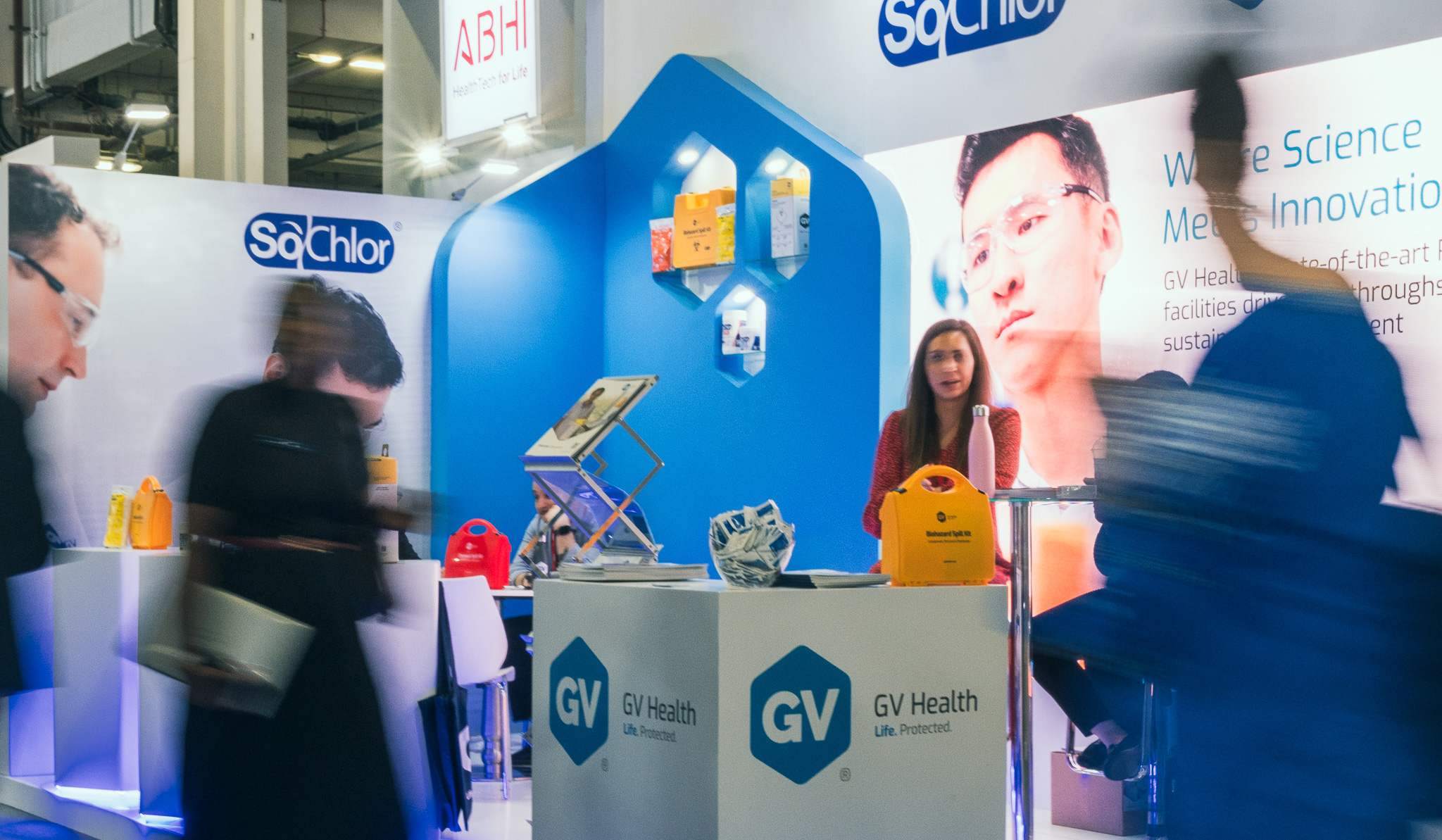Preparing for the Next Pandemic – What Lessons Have we Learned ?
Recorded on 20th March at The Cleaning Show 2025 at ExCeL London, this expert panel discussion explores the progress made in the cleaning and hygiene sector since the pandemic and outlines the steps still needed to drive further improvement. The panel included GV Health’s Technical Director, Duncan Holdsworth.

0:03
Good morning everybody.
0:04
Thank you for joining us for Thursday’s first panel session,
0:09
which is entitled Preparing for the Next Pandemic.
0:12
What lessons have we Learned? Um, I’m Neil Nixon.
0:16
I’m the conference director for this event,
0:18
and I’m delighted to be joined
0:20
by Duncan Holsworth from GV Health,
0:23
by Matt Dean from ISS from Paul
0:27
through from the IWSA morning.
0:30
And on the end there, Wes Smith from the Clean Space.
0:33
Perhaps I could just ask each of you by way
0:36
of introduction just to say a little bit about who you are,
0:39
what you do, and then we’ll get started on the discussion.
0:43
Brilliant. So my name’s Duncan Hodsworth.
0:46
Um, I’m the Technical Director at GV Health.
0:49
We are a science
0:50
and technology company specializing in,
0:52
in infection prevention and control solutions.
0:54
So that covers a whole range
0:55
of different disinfectants cleaners.
0:57
Um, what else have we got?
1:00
We’ve got spill decontamination
1:01
systems, those types of things.
1:03
Um, so we are very much working towards innovation
1:06
development, um, looking to see how we can help.
1:10
Matt. Good morning everyone. Uh, Matt Dean from ISS uk.
1:14
You’ve probably all heard of ISS.
1:17
Um, my role within the organization is to design
1:21
how we clean and what to clean with.
1:23
So in the event there is another pandemic,
1:26
then it will probably be sit with me to draw up a plan as to
1:31
how do we respond to that, um, as part, as well as working
1:34
for ISS and also a board member for CSSA.
1:38
Paul Morning, everybody. Uh, Paul Repe.
1:41
Uh, I retired from OCS, uh, last March.
1:45
Um, former BCC Chairman.
1:47
And, uh, recently this year, uh, takeover as the chair
1:52
of the IWSA, the IWE,
1:55
which is the Independent Washroom Services Association.
1:59
And we consist of around 34 member
2:03
companies all independently owned
2:06
that provide washroom services.
2:09
I’m Wes. Good morning everyone. Uh, I’m we Smith.
2:12
I’m with the Keen Space.
2:13
We’re a commercial cleaning company operating outta the UK
2:16
for the last 21 years.
2:17
And for my sins, I’ve also spent 21
2:19
years in the cleaning industry.
2:21
Um, I’m the sales and marketing director
2:23
for the clean space at the moment
2:24
and look forward to being part of the panel.
2:27
Thank you. Well, this is obviously a very broad topic
2:31
and we could, uh, we, it could go in any direction I,
2:34
I imagine, but we have a, a great panel of, of scientists,
2:38
of product specialists, of contractors.
2:41
So we should get a very rounded view on what went well,
2:45
what went badly last time,
2:47
and what we might do to prepare better for a pandemic,
2:52
should we be faced with another one in the future.
2:55
So, well, let’s start with Duncan
2:57
as he’s sitting near us to me.
2:59
Um, what, from a, a science perspective, maybe
3:03
what did go well last time
3:05
and what could we do be, could we have done better
3:08
with the benefit of hindsight?
3:11
Well, I think there was a, there are a number
3:13
of existing chemistries
3:14
and, um, disinfectants, for example,
3:17
that were very effective.
3:19
Um, maybe the opportunity was
3:22
that they weren’t necessarily using
3:24
the best way they could have been.
3:25
Um, you know, for example, there’s a lot of, lot
3:28
of chlorine based disinfectants that were used.
3:30
And although it’s an incredibly effective chemistry, um,
3:33
there’s some environments it was maybe being
3:35
overused a little bit.
3:36
And from my perspective, it was looking at the system
3:40
as a whole and looking at, well, actually we need
3:42
to be incorporating cleaning and disinfection together,
3:44
making sure that we are incorporating that
3:46
with the best training, the best methodology,
3:48
the best auditing, um,
3:50
and making sure that we inform all the key decision makers,
3:52
particularly sort of the senior buyers within the relevant
3:55
organizations, um, as to, you know, how to not just buy,
3:59
but also how to use the products properly.
4:02
So I think there are a number
4:03
of very effective products used.
4:05
Um, at the time. The way it can be done better is making
4:07
sure that we inform and educate so
4:09
that people know best practice.
4:13
And Matt, as a product specialist, and,
4:16
and you know, the supply chain was something
4:18
that came under enormous pressure at the start of the,
4:22
uh, of the pandemic.
4:23
What have we done to secure that, make that likely
4:27
to be better next time around? Do you think?
4:30
I think as we discussed it previously, is that the,
4:34
the last pandemic treat that as a dry run is that was our,
4:38
that was our practice.
4:40
Um, we probably all had a business continuity plan in place.
4:46
Maybe it never really saw the lighter day, um,
4:49
until we actually then face the pandemic.
4:52
But now we see the value in having that kind of document.
4:56
And as part of that plan is, well, what,
5:00
what do we do about our supply chain?
5:02
If in the event something like that happened again, so prior
5:06
to, um, COVID-19, that was my responsibility
5:10
for the organization I worked in.
5:11
Um, local authority is
5:14
what do we do in the event of a flu pandemic?
5:17
Now, when I sat down to write that, I was, uh, criticized
5:22
for being a little bit too out there.
5:24
That’s potentially none of this would actually happen.
5:27
Well, several months later it did.
5:29
And unfortunately, some of the wild ideas that I’d come up
5:33
with actually then was put into place.
5:35
So, um, one
5:37
of the things was actually the supply chain in terms of
5:40
what do we, what do we learn from the,
5:42
the previous experience is, well, we, it was a case
5:46
of we just grab whatever was available,
5:49
but now we can actually sit down
5:50
and discuss with our supply chain, our suppliers, well,
5:54
what will happen next?
5:55
And that’s the key thing is let’s not wait
5:58
until the next one before we have that discussion.
6:00
Treat it as part of your business continuity plan
6:03
is if in the event it does happen again, what will you do
6:08
to, to support us in our, in an in r operation.
6:11
Now, if you’re a supplier, that’s a,
6:12
that’s a completely different discussion.
6:14
I don’t have any of the experience from a supplier’s point
6:17
of view, but if you’re a building contractor, you,
6:19
your client will be relying on you to be able to make those,
6:23
um, decisions, put those actions in place.
6:25
But you can only do that with all of the network
6:28
of suppliers that you, you have
6:29
to help you run your business.
6:34
I know none of us on here are suppliers,
6:36
but do you think your suppliers have a more robust process
6:40
now by which they would be able
6:42
to ensure should you need product quickly,
6:44
you would get product quickly?
6:46
Yeah, I think the, the lessons learned was
6:48
that everyone was caught out.
6:50
And so therefore, although it might not necessarily sit on
6:54
a, a regular discussion as part
6:56
of our quarterly business reviews, it, it is a discussion
6:59
that has been had that in the event it does happen again,
7:03
we’ve had those assurances from our suppliers
7:06
that they would be able to cope with that demand
7:08
because it, it was one of those things
7:10
that nobody probably expected it to happen, but it did.
7:13
Um, and, and we were caught out.
7:15
Um, we did the best we could.
7:17
Um, and we, we just need to make sure that next time round
7:22
we we’re, we’re, we’re, we’ve got
7:24
that reassurance from the supply network that
7:26
what will happen, that there is a plan.
7:30
Paul, I think the washroom is obviously recognized as one
7:34
of the first lines of defense in, uh,
7:37
in tackling these types of situations.
7:40
Do you want to tell us a little bit about your new
7:43
association and then also more broadly about the role
7:47
of the washroom and
7:48
how we can better prepare washroom environments to,
7:52
to help counter such an event in the future?
7:55
Yeah, of course. Uh, I mean, one of the big,
7:58
big plus points if there was in terms of covid,
8:02
was the high profile it gave to the, uh, cleaning
8:06
and hygiene industry.
8:07
Uh, it was a shame, it had to be a pandemic to, uh,
8:11
to get our cleaning staff
8:13
and all of our supply staff recognized.
8:16
But you know what, it, out
8:18
of some adversity came a little bit of good there.
8:21
Um, I think the washroom part of that is
8:25
absolutely vital, uh, in terms of
8:28
how we provide those clean environments so
8:32
that people can maintain even simple hand hygiene,
8:36
which has such a positive effect on, um,
8:39
on stopping the spread of such, um, diseases.
8:43
Um, I think one of the, one of the problems we have is
8:48
that I’m not sure that we’ve learned too much from it
8:52
because it appears that many, many, uh,
8:56
organizations have gone back to pre pandemic levels.
9:00
And, you know, there’s evidence that a lot of the hygiene
9:05
practices that were in place, um, before covid
9:09
and then then were enhanced
9:11
because of the pandemic have suddenly disappeared again.
9:14
And, uh, and people are going back to basic hygiene.
9:18
Well, as an association, our members are really keen
9:22
to ensure that that doesn’t happen.
9:25
Um, we go around
9:26
and we see so many san, um,
9:29
sanitizers are dispensers that are empty.
9:33
You go into public spaces, restaurants, pubs,
9:38
anywhere, and you’ll find empty sanitization dispensers,
9:42
which is such a shame.
9:44
So our members are working hard behind the scenes.
9:47
You all alluded to terms
9:48
of making sure there’s sufficient resources available.
9:52
They’re working hard to make sure
9:54
that those resources are there
9:56
and advising all of the businesses that, you know,
9:59
hand hygiene hygiene in the washroom is absolutely vital
10:04
and will help us prevent a recurrence of
10:06
what happened a few years ago.
10:09
Yeah, absolutely.
10:10
Whereas as a, somebody providing a frontline service
10:14
as well, what, what changes have you made as a contractor?
10:18
You know, how have you, um, uh, uh, evolved your training
10:22
and education processes to your staff?
10:24
You know, is that been something that’s continued to evolve
10:28
or as Paul says, have we all slipped backwards a little bit?
10:33
Yeah. Uh, I think initially at the onset of, of the kind
10:37
of the outbreak, you had Tinas
10:40
overnight becoming frontline workers.
10:41
Um, and in many cases,
10:43
unless they spent time in the healthcare environment,
10:45
in large part, they hadn’t received formalized training on
10:48
proper infection control.
10:50
Um, I’m not saying that’s unanimous,
10:52
but it certainly was very much the case.
10:54
And overnight, you had to find ways to roll out
10:57
and mobilize efficient training to equip frontline workers
11:00
of proper infection control, uh, correct PPE usage, uh,
11:04
proper cleaning and sanitization and disinfection protocol.
11:08
Uh, so that,
11:09
I think from the onset has made you think about the delivery
11:13
and method in which you’re going to spend time training,
11:17
cleaning operatives, your supervisors,
11:19
right up the line into your management teams.
11:21
And one of the things with the coming of digital age,
11:24
it’s about the use of technology to try
11:27
and speed up the efficiency
11:28
and the effectiveness of that training.
11:29
So what we’re finding, particularly within ourselves,
11:31
the clean space is spending a lot more time focusing on
11:34
digitizing as much of the training program as possible,
11:37
making sure that we don’t leave simple training, uh,
11:41
and not a nice to have infection control training.
11:44
It’s actually a must as part of the process
11:46
and making sure that comes part of your training modules
11:48
as you train your cleaning officer operatives
11:51
and supervision and teams.
11:52
I think there’s also an element of making sure you lean in
11:55
with your service supply chain partners, um,
11:58
so the experts sitting on the right that can help come in
12:01
and support the business with the right type
12:03
of training and understanding.
12:05
IE train the trainer, right?
12:07
Get them to understand the real background
12:09
and theory behind what it,
12:10
what infection control looks like, the prevention
12:13
of future virus outbreaks,
12:14
and how to then instill that down, down, cascade
12:19
that down the level to the sort of the cleaning operative.
12:21
And I think being efficient and effective in that is part
12:25
and parcel of the responsibility of the cleaning, uh,
12:28
business and the cleaning industry.
12:30
Making sure we can digitize it and deliver it quickly
12:32
and efficiently is probably the best way forward,
12:34
and that’s what we are focusing on at the moment.
12:36
Yeah, I think, uh, picking up on something Paul said, um,
12:41
you know, the, the COVID did elevate the, um, profile
12:45
of our industry for a while,
12:47
but it was quite a short period as it turned out.
12:50
And there were a number of, um, initiatives put in place.
12:55
The British Cleaning Council worked very hard to
12:57
create an A PPG within government, um, which
13:02
has slightly derailed.
13:03
Um, did we miss an opportunity or is there an opportunity?
13:08
One of the things that has come up in a number of sessions,
13:12
uh, during the conference this year has been
13:14
how do we attract good young, new talent to the industry?
13:18
And one of the ways we should be able to do that is
13:21
by the industry having a higher profile.
13:23
Do you think as a panel, we’ve, we’ve lost that opportunity
13:26
or have we merely missed it
13:28
and there’s still an opportunity there, happy for you to,
13:33
Happy to answer.
13:34
Uh, I don’t think we’ve missed the opportunity.
13:36
I think it’s, uh, it’s maybe just took a
13:39
bit more of a backseat.
13:40
Uh, obviously we had the elections
13:43
and sort everything sort of came to a bit of a halt.
13:46
Um, however, I think we all have a responsibility
13:50
to get that momentum going.
13:52
And, um, you know, the A PPG was formed with the BCC,
13:56
uh, it’s still there,
13:58
but we need to really get some traction.
14:00
We need to put some pressure on the MPS to, um,
14:04
support our industry.
14:06
Um, if, if you think about key worker status,
14:10
when I was in the chair, one of our key themes was,
14:13
was trying to get everybody within the industry,
14:16
whether they were a, a cleaning operative
14:18
or whether they were a washroom operative,
14:20
whether they were a supplier, was
14:22
to get them key worker status.
14:25
And we still haven’t got that.
14:27
And if we, if we have another pandemic tomorrow, all
14:31
of our team will be unable to work until we can get,
14:35
get them, um, that key worker status.
14:38
Yep.
14:41
I mean, I dunno, uh, Duncan, you,
14:45
you’ve made comment to me in the past about, uh, you know,
14:48
that, that that responsibility, if you like,
14:53
on the cleaning sector,
14:54
there’s almost a responsibility on the cleaning sector
14:57
to educate the public rather than relying on
15:00
politicians to educate the public.
15:02
Is is that a fair summary of how you feel about it?
15:06
Absolutely. Is IPC sort of solution providers,
15:09
which GV Health are, um, there’s a lot that we can do
15:12
to educate and inform, um, that’s both at a public level
15:16
but also at a government level.
15:17
And I think a big part of this is, is engagement.
15:19
And actually, you know, there’s a lot of capability
15:21
and talent today in this room,
15:23
and it’s everybody coming together as a single voice
15:26
to really explain to government as well.
15:28
And also to link it back to what the collateral cost of all
15:31
of this is, which is human lives at the end of the day.
15:33
And trying to continually reiterate that.
15:35
We’ve had some amazing speakers over the last couple
15:38
of days, you know, asking the question, you know, instead
15:41
of going, how expensive is it gonna cost us
15:44
to be invest in training?
15:45
It’s more flipping on its head
15:47
and well, you know, to create dealer accountings,
15:49
it’s, can we afford not to?
15:51
What is the damage of not doing this?
15:53
And I think what that will do is it will inform
15:57
and educate new people in our industry
15:59
and bringing new talent in.
16:00
And I think hopefully it will reiterate the importance
16:03
of continually investing in ongoing sort of biosecurity.
16:09
Yeah, I mean, Danny, Matt,
16:11
Yeah, it was mentioned yesterday is
16:13
that cleaning touches everybody,
16:15
every aspect of everyone’s lives.
16:17
So whether it’s a, uh, a topic that politicians want
16:22
to talk about or not, to some extent,
16:25
it may even be irrelevant
16:26
because we have a relationship with every single
16:30
organization that pretty much exists in this country,
16:34
and we clean their buildings.
16:36
Um, whether that’s a public building
16:37
or a private building, the fact is
16:40
cleaning takes place everywhere.
16:41
So we all have a responsibility as contractors to ensure
16:44
that we raise the profile with our clients,
16:49
explain the importance of what it is that we do.
16:51
If they don’t get it already that way every,
16:54
whether we the message goes out from a public media
16:57
or whether we do it by stealth through our clients,
17:01
the message will get out there.
17:02
Um, we just need to keep on chipping away, uh,
17:05
and explaining the importance of what it is that we do.
17:09
Yeah, I think messaging has been, um, is always
17:13
that the key to this, I, I spoke
17:14
to somebody from TFL recently who said one
17:17
of their biggest challenges now is getting people
17:20
to hold handrails on escalators.
17:22
Their biggest source
17:23
of accidents on London Underground is people
17:26
falling down escalators.
17:28
And he said, we spent two years telling people not
17:30
to touch anything and, and now we’ve gotta try
17:33
and teach them to touch them.
17:34
Now in that instance, they’re using technology
17:37
to clean those handrails,
17:39
but of course the public don’t know that
17:41
because there’s no signage, there’s no education.
17:44
So that strikes me as part of the challenge
17:47
and how we as an industry adopt
17:51
that responsibility.
17:53
I’m not not sure how that would work.
17:55
What, do you have a feel on that, Wes?
17:58
Yeah, I think, I think one of the key parts
18:02
of making sure is make we internally
18:05
between our supply chain partners
18:07
as a cleaning service provider,
18:09
get a good thorough understanding of
18:10
what technology’s out there.
18:11
This event showcases what’s out there at the moment,
18:14
the new innovation, new tech, what’s happening,
18:16
make sure we have a really good understanding,
18:18
good relationship with the partners we want to deal with,
18:20
and make sure we ourselves have the right knowledge.
18:23
It’s then gotta be passed down within the organization
18:25
to our operational teams
18:26
who are effectively using this correctly.
18:28
And then more importantly, it’s also gotta translate into
18:31
our sales and marketing teams.
18:32
And, and the messaging
18:33
that we utilize is not just about consultative selling,
18:36
but actually educationally consultative selling,
18:39
being bit bit of education to the customer base,
18:41
your existing customers, new customers that are out there
18:44
when we’re introducing new technology is making sure we are
18:47
educating and getting the message correct.
18:48
Not everybody will understand the very high tech levels
18:51
of it, but being able to distill it in a way
18:53
that our customers can adopt, understand it correctly,
18:56
and then finding the right practical applications and,
19:00
and then making sure that messaging lands so
19:03
that we can get those applications used.
19:05
I think there is a balance that needs to be found between
19:08
the adoption of technology and,
19:11
and the visual cleaning that needs
19:13
to be taking place in the background.
19:14
And the two have to almost coincide together
19:16
because there’s always gonna be that requirement
19:18
to see the cleaning taking place in some respect or another.
19:22
And it’s finding a balance on where to use tech
19:24
and where to have that openly visual cleaning aspect.
19:27
Cleaners have certainly come to the forefront since Covid
19:31
and certainly the, the cleaning operative
19:33
and the cleaning industry is seen in perhaps a,
19:36
a more essential light than what it probably used to be,
19:38
which was hidden outta sight outta mind.
19:40
Where now with the adoption of it,
19:42
there is a bit of a wean off.
19:43
You know, there’s not as much sanitization
19:45
and disinfecting going on
19:46
because cus companies are having to take a step off on that.
19:50
But we have to make sure that we still keep reminding them
19:53
of how important the industry is
19:54
and cleaning s are and the processes are.
19:57
Yeah. So IPC products have to be effective
20:01
and cost effective.
20:04
Um, Duncan, you know, you are,
20:06
you are right at the forefront of developing
20:08
that these types of products.
20:10
Picking up on Wes’ point about people wanting to be seen
20:14
to be cleaning as well.
20:15
Does, does that, does the whole thing,
20:17
does the whole thing have to work together
20:20
or do these, um, products
20:22
that you can leave on surfaces for longer?
20:25
Do they have a place, you know, how, how’s
20:27
that all gonna pan out in terms of public confidence?
20:31
Hmm, Nice. Easy question.
20:35
Yeah, absolutely. Um, well there’s, there’s a lot of IPC,
20:39
you know, products and solutions
20:41
and services in this space,
20:42
which all which all have a place, right?
20:44
And in terms of the visibility of it, you know, a lot
20:48
of it does come back to training education again, you know,
20:51
and, and making sure that also our, our own sort
20:54
of cleaning professionals are, are advocates
20:56
of the products that they use.
20:57
And the best way we can do that is by helping them
21:00
to understand, you know, the, some of the science
21:02
and some of the methodology behind that.
21:04
Um, I think there’s a, there’s a lot
21:07
of potentially missed opportunities in with some
21:10
of the products we currently have within the IPC space.
21:12
’cause we have some very effective products,
21:14
but they’re not necessarily always used in the best way.
21:17
And sometimes that can also result in overuse
21:19
of chemical wastage, which obviously comes at a cost.
21:22
So by making sure that we inform best method in terms
21:26
of making sure that you only use for, you know, the, the,
21:29
the absolute necessary quantity of a chemical.
21:31
And maybe let’s say when it comes to disinfection, you know,
21:34
it’s about using disinfectants, um,
21:37
in the right place at the right time
21:38
and maybe then using those in combination
21:40
with other chemicals for cleaning, for example.
21:43
But naturally you can get the best of both worlds
21:45
because we did, we, we know we’ve, we’ve come across a lot
21:47
of customers coming back to us saying, okay, during the,
21:50
the height of a pandemic, we were using almost exclusively
21:53
disinfectants on all of our surfaces.
21:55
And I think what we’re, what we’re now seeing is almost a
21:57
pendulum swing b to the other side, where along with going,
22:00
well a lot of those disinfectants,
22:02
’cause they’re quite reactive chemicals,
22:03
they’re not necessarily very compatible
22:05
with a lot of the surfaces.
22:06
It’s creating some issues for us now.
22:08
We want to move away from that entirely.
22:10
And I think what we’re trying to bring into the,
22:12
into the conversation is saying, well,
22:14
don’t move away from these entirely
22:16
’cause there’s a reason they were there in the first place,
22:18
but you should, working with them more smartly
22:20
and using them in combination with other processes
22:23
and it becomes a system, it becomes a, you know,
22:26
a a combination of parts so bigger than for some
22:29
of its parts in terms of, you know,
22:30
the right right methodology, the right products,
22:33
um, the right education.
22:35
And I think that way we can,
22:36
we can make some pretty quick progress.
22:38
So it’s kind of my low hanging fruit for me.
22:40
You know, I see new products continually entering the space
22:44
in IPC and that’s a great future solution.
22:46
We have a lot of immediate opportunities in terms
22:49
of just showing
22:50
how the existing products can be
22:52
used in a much more effective way. Yeah.
22:54
And Matt, in your role, how,
22:57
what role does the manufacturer
22:58
and the developer have in that sort of training
23:01
and education process in helping you
23:03
select the correct products
23:05
and then helping you inform your
23:08
frontline staff in how they should be used?
23:11
So Typically any manufacturer,
23:15
they’ll supply the product along with training.
23:18
So if, if any good manufacturer
23:20
that you’re purchasing from now today supplies
23:22
that training, please take advantage of it.
23:25
Um, although hard work has already been done in terms
23:28
of making it, um, accessible for people to be able to learn
23:33
how to use the the product correctly, I think one
23:36
of the things that we learned from the pandemic is the
23:39
misunderstanding around what products do what.
23:41
So there was an awful lot of people buying, um,
23:44
disinfectants, but that product was there
23:47
to tackle a bacteria.
23:50
Well, co covid was a virus, so we were potentially,
23:54
or really using the wrong products.
23:57
So there is some education required from the manufacturers
23:59
to ensure that we are purchasing the right, um, products
24:03
and materials to tackle whatever we’re dealing with.
24:06
But having, taking advantage of their training, uh,
24:10
materials helps us deliver that message
24:13
to the frontline cleaning operatives.
24:15
Um, there was another bit to your question,
24:17
which I wasn’t sure whether I’ve answered now. Um,
24:20
Yeah. Well, and how do
24:21
you pass that information on
24:22
to your frontline team?
24:24
Yeah, so any good cleaning contractor should be
24:29
training their staff anyway as a minimum.
24:31
Um, I think one of the things that came out of it is
24:34
that maybe the, the training in some cases
24:37
wasn’t as great as others.
24:39
Um, if, if what we’re asking our operatives
24:43
to do is sign a box, uh, sign a form to say that we’ve gone
24:47
through cost assessments and method statements
24:49
and that’s as much as their training consists, then
24:52
that might probably not be enough.
24:55
Um, we can’t rely on that level of training.
24:57
It does require that little bit extra.
25:00
So there, there’s probably gonna be a little bit
25:02
of a plug now to my colleague sat across there
25:04
from, from Bix.
25:06
Um, in terms of chemical competency, that’s,
25:09
that’s a good starting base for understanding
25:12
what chemicals do, what, how to prepare them correctly, how
25:15
to apply them some, something as simple as contact time.
25:20
Nobody, you talk to people
25:21
and they don’t even realize that there’s a contact time
25:23
for, for products.
25:24
So spray, wipe
25:26
and dry, that’s, that isn’t necessarily gonna be enough.
25:29
So Making sure that we have a, a robust training program,
25:34
make sure everyone is captured in all of that.
25:36
What skills do they need to be able to perform their job?
25:40
Chemical competencies, just the minimum,
25:42
the ACT app application of products, um, whether
25:45
that be d wiping, damp mopping, whatever that might be.
25:48
Make sure that that’s all covered.
25:50
Um, don’t just take it for granted that they clean at home,
25:53
that they mean they know what
25:54
they’re doing in the workplace.
25:56
’cause it’s, it’s completely different out there.
25:57
We’re asking them to do above
25:59
and beyond what they do at home.
26:01
And can, if I can just jump in there, the other thing
26:03
that underpins a lot of this is terminology, right?
26:05
The way that we refer to the products
26:07
and the processes, you know, what do we mean
26:09
by when we say cleaning or a disinfectant or a sanitizer?
26:12
I mean, even within disinfectants you have low level
26:15
disinfectants, medium high,
26:17
and they all have different scopes
26:18
of antimicrobial activity.
26:20
And I think that car terminology is more important than ever
26:23
before, particularly when it comes to preparing
26:25
for the next pandemic because, you know,
26:27
the SARS-CoV-2 virus was, um, you know, something
26:30
that could be killed by a lot of existing chemistries,
26:32
but there’s no guarantee
26:33
that those same chemistries are gonna be capable
26:35
of killing the next pathogen responsible
26:38
for the next pandemic, which I think is
26:40
somewhat of an inevitability.
26:42
So it’s also making sure that we are best positioned
26:45
to select the right chemistries, which have, you know,
26:47
the broadest possible spectrum of antimicrobial activity
26:51
to account for the multitude
26:52
of possibilities we may encounter in the future.
26:56
And different environments require different solutions.
26:58
That’s correct. Yeah,
27:02
I think, I think, um, Sorry, I was just gonna add
27:05
that we we’re effectively putting our
27:07
operatives on the front line.
27:08
It’s a, it is a dangerous place, da dangerous environment
27:11
that we’re putting them into.
27:13
Um, so the, the training not necessarily from a, um,
27:17
quality output
27:18
or whether we’ve actually determined
27:20
that we’ve actually killed the virus, we’re, we’re intending
27:23
to kill, but it’s actually first
27:25
and foremost protecting our staff.
27:28
So the training is there to ensure
27:29
that they turn up the following day, we carry on that,
27:32
that essential work that they’re doing.
27:34
So the training for, for, for first
27:38
and foremost has to be about how to protect themselves in,
27:41
in what effectively is a dangerous environment.
27:44
Yeah, it’s worth that.
27:45
In addition to bs, the BCC also have a plethora
27:49
of training courses there to support.
27:51
But when we talk about technology
27:52
and we talk about products, then if you, if you take the,
27:56
um, IWSA as an example, our members are real experts
28:01
in washroom maintenance, uh,
28:04
and they will be able to identify the best mix
28:07
of treatments for those washroom.
28:09
So whether it’s a technological in terms
28:11
of an air sterilization or touchless systems,
28:15
or whether it’s actual products, talk to our members
28:18
of the IDSA
28:20
and you know, it comes free as part of the service.
28:22
They supply a great service, but they will offer advice
28:26
and support and they’re experts in, in what needs
28:29
to happen in, in these situations to talk to the experts.
28:33
And that will help everybody maintain a
28:36
much better environment.
28:38
Yeah, it’s an excellent point.
28:39
I mean, the IWSA is now a member
28:41
of the British Cleaning Council.
28:42
The British Cleaning Council has a huge number
28:45
of associations under its umbrella that, uh,
28:48
can offer an enormous amount of advice on, on, uh, product
28:52
selection, training, education, et cetera.
28:55
Um, I’m conscious of time, I want to give the audience
28:59
a five minutes or so,
29:00
but whereas compared to other international markets,
29:05
which perhaps you have a, a better understanding
29:07
of than most of us, how do you think we,
29:11
we reacted in the uk
29:13
and how do you think we are in terms of preparedness for
29:17
a potential second pandemic?
29:20
Sure. Um, so I spent the initial part of, um,
29:24
COVID-19 pandemic in South Africa at the time.
29:27
Uh, having been spent a couple of good couple
29:29
of years here now, and having listened to what took place,
29:32
I think much of the beginning was a lot of the same,
29:34
where there was a lot of uncertainty.
29:36
Um, not a lot of people reacted quick enough at implementing
29:40
that first line protocols in terms of wa mask,
29:42
wearing social distancing,
29:43
making sure they get their workspaces equipped
29:45
with the right amount of hygiene standards.
29:48
Um, but going into kind of the lockdown phases when
29:51
that spread got a bit worse,
29:54
there was almost no talk in South Africa
29:56
around should we keep schools open, you know, herd,
29:59
mental herd immunity.
30:01
It went straight into sort of very severe lockdowns.
30:04
There was a total ban on tobacco,
30:05
total ban on alcohol sales.
30:07
Uh, you weren’t allowed outside to do any form of exercise.
30:11
There was curfew bans, even
30:12
for essential front lock workers at nine o’clock.
30:14
So the lockdown restrictions were extremely intense, um,
30:18
and it lasted the better part of sort of five months
30:21
before you could even go and get a haircut.
30:23
So, you know, it was, it was quite, quite extensive in terms
30:25
of locking down and whether or not, I can say for sure
30:28
that helped curb it a lot quicker than potentially uk.
30:31
I think that’s up for debate for everybody.
30:33
I know it was a big struggle
30:35
and a lot of people suffered job losses,
30:38
particularly in industries where the,
30:40
like the cleaning sector
30:42
businesses just shut down overnight.
30:43
You know, tourism trade got hit, restaurants, pubs, bars,
30:47
um, the nightlife, um, sort of dance halls
30:50
and things like that, they all kind of shut down almost
30:52
overnight and just some of them largely didn’t reopen again.
30:55
So businesses in general got hit quite extensively.
30:58
I think the difference part here is where
31:00
the UK have still stuck with a bit of that, um, home working
31:04
or hybrid working environment.
31:06
South Africa almost went all back to work as soon
31:08
as they could, that that technology led work from home
31:11
ability didn’t really take place in South Africa so much.
31:14
So I think from that side of things,
31:17
it helped did boost the economy a bit back
31:19
to life a bit quicker, I think,
31:21
in South Africa than maybe here, um, particularly in sort
31:24
of the cleaning space or the cleaning
31:25
as a cleaning service provider.
31:27
Um, so yeah, from, from that side, I think there,
31:30
each country will react differently.
31:33
I think it is about, you know, population density,
31:36
housing density, um, demographics, just a whole bunch
31:40
of different things go into a malting pot
31:42
and how countries will react to the next pandemic.
31:46
Um, I do think there’s a lot of positives that you can take.
31:49
Um, in terms of, from a UK perspective,
31:51
they got vaccine rollouts extremely well.
31:53
You guys were on your third round
31:54
of vaccines when South Africa
31:56
were only starting their first round.
31:57
Um, so you take those type of things into account.
32:00
I think the, the bounce back was incredibly well,
32:02
the way people reacted, um, was incredibly well the,
32:06
basically the adoption of those first line protocols
32:08
and things like social distancing, distancing,
32:11
and wearing masks were, were pretty much the same.
32:14
Thank you. I mean, Paul, on the backdrop
32:17
of the Covid inquiry, perhaps not going as far
32:21
as we would’ve liked it to as a, an experienced, um,
32:25
contractor and as you say ex-Air of the BCC,
32:31
how do you feel, you know, you are proud of this industry?
32:34
Do you feel we’re a better placed, uh,
32:37
to handle such problems in the future?
32:40
I think, I think the industry is
32:42
definitely in a much better place.
32:44
I think the wider world doesn’t realize
32:47
that we are in a better space,
32:48
and I don’t think they treat our industry
32:52
with the respect that we deserve.
32:54
You know, with a top five employer in the uk
32:58
and, um, everybody within the industry has a real passion.
33:02
Um, I mean, people say, I’ve got a passion, you know,
33:05
people in the industry all have a passion, passion,
33:08
um, and it’s a lot of fun.
33:10
And you talk earlier about how do we attract young people?
33:14
Well, I think if we could just show some of the success,
33:18
success stories of the people within our industry
33:22
that surely will attract people to our industry
33:24
because, you know, we’re really, really good at what we do.
33:28
And whether it’s wash rooms
33:30
or whether it’s providing cleaning to premises,
33:33
whether it’s providing chemicals, the solutions,
33:37
we’re right at the top of the world with all that,
33:40
but we don’t shout enough about it.
33:42
So I think as an industry, all of us get that passion going,
33:46
shout about it, and, uh, let’s get the government
33:49
to follow it, to support us a bit more.
33:53
That feels like a positive, uh, note on which to ask if,
33:57
uh, we’ve got five minutes
33:59
or so, if, if there’s anybody in the audience
34:01
that has anything to ask of our panel, please,
34:04
uh, let us know.
34:09
Bamboozled them all. Well, in which case
34:13
I will thank our panel very much for their participation.
34:16
I thank you very much for joining us
34:18
and um, our final session for cleaning show 2025,
34:23
we’ll start at 1215,
34:25
so please make your way back here in a short while
34:29
and, uh, we look forward to seeing you again then.
34:31
But thanks very much to our panel.
Others are viewing
Healthcare professionals who view this are also viewing

Advancing Infection Prevention: Our New Scientific Test Methods Unveiled at IP2025

Life Protected Cleaner (LPC) Q&A with Kirsty Bradbury, Nottinghamshire NHS Foundation Trust

Biohazard All-In-One Spill Kit / Pack – Procedure Training

The Deceptive Convenience of QAC Sanitisers in Healthcare

Addressing the Threat of CPE: Why SoChlor DST is a Trusted Disinfectant

Selecting the right disinfectants for UK Healthcare, the benefits of SoChlor over reactive disinfectants

GV Health’s Life Protected Cleaner (LPC) awarded Highly Commended in Innovative Product of the Year category at Cleaning Excellence Awards 2024












